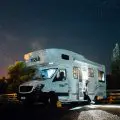Hey! This site is reader-supported and we earn commissions if you purchase products from retailers after clicking on a link from our site.
As a rule, your RV will have two separate electrical systems that draw different voltages as well as two different types of current. Just as a “sticks and bricks” home is based upon 110/120v power system, so is your RV.
However, because your mobile home away from home is also dependent upon using a 12v system and in this article, we’ll take a look at some of the components that make up your system and what they are meant to do.
We’ll look at:
- Different power sources you can use
- Each component of your electrical system
- Proper setup of wiring, breakers, and fuses
- Where you should include outlets
- Other pro tips and watch outs
What are my sources of electrical power when traveling in my RV?
Unless you’re special ordering a manufactured motorhome or towable RV, the two basic sources of electricity in a manufactured RV will be shore power and house batteries which I will explain below as well as some alternative sources for power such as solar power and generators.
What is shore power?
Although this term is commonly used when referencing boats or marine vessels when docked at a marina and plugging their electrical system into the main grid used by the marina, the term is also used when referring to RVs being plugged into a main power grid supplied by a campground or an electrical circuit at someone’s home or business.
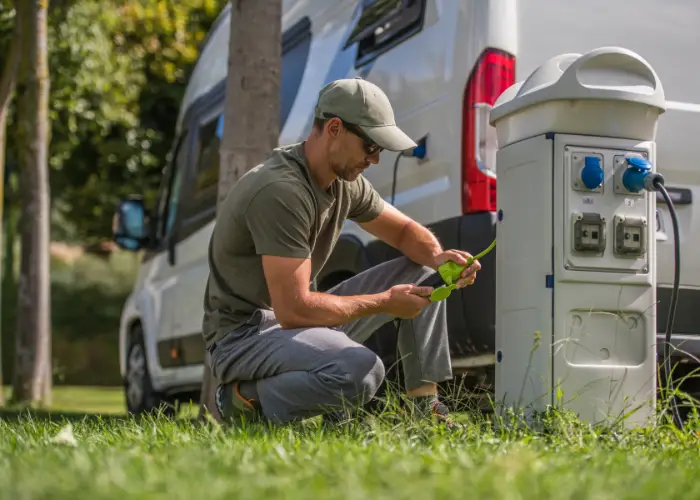
Most manufactured motorhomes and campers will have an electrical system and long power cord that allows you to plug into shore power, although some older models may be missing this feature especially if your RV was built before 1970.
Should you be doing a custom build or restoration of an RV, installing a shore power can be very simple to more complicated depending upon how you want your power supply to operate and the number of items you wish to power.
For example, you may have a small van that you have converted to an RV and it is wired with 12v lights and RV refrigerator, but you want to add a 110v line because you want to power a laptop computer, charge your camera batteries or watch some television.
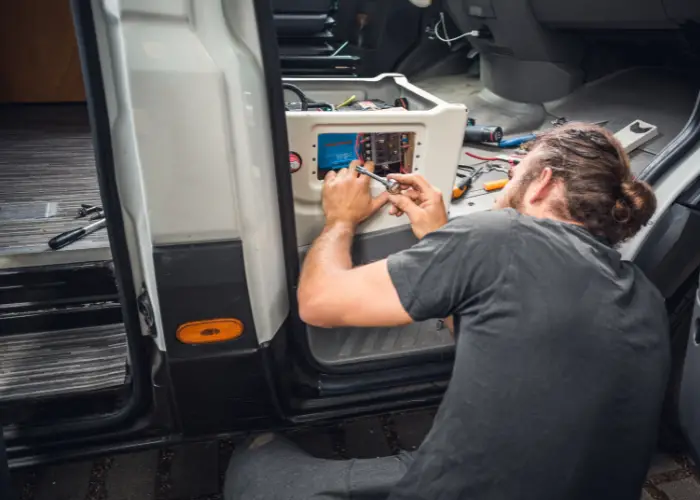
Adding one or two outlets like this can be done easily by simply installing a weather appropriate inlet on the side of your van that is wired directly to those indoor outlets on a single line. This works well for people that have a limited need of shore power and you only need a good outdoor 110v extension cord to run from the power box or outdoor outlet to your inlet.
However, the larger your RV, the greater your shore power needs will be too. Generally, class A motorhomes are equipped with a 50-amp power plug and class C may have either a 50-amp or 30-amp power plug. Class B motorhomes are usually 30-amp as are smaller campers. Remember, the more bells and whistles you have on your RV determines the amount of amperage you will need.
Another thing to keep in mind when RVing is that smaller and older campgrounds may not have the electrical outlets that your rig requires. It’s not unusual to find many campgrounds are only supplied with 30-amp outlets. To avoid this happening to you, I would recommend that you purchase an adapter that takes your 50-amp power supply down to a 30-amp supply.
The downside of this, however, is that you will need to be especially mindful of the amount of electricity you are drawing at any given time. When your system is designed to be running efficiently at 50-amps and you lower the intake to a 30-amp draw while still trying to run as many appliances, electronics, and air conditioning then it is likely you will blow a fuse or pop a breaker.
What are house batteries?
Most RVs will have at least one deep cycle trailer battery that is used to supply power to 12v outlets and appliances such as exhaust fans, carbon monoxide detectors, RV style refrigerators, and some lighting. Usually, the bigger the RV, the more batteries you are likely to have.
- UB121000 SLA is a 12V 100AH Group 30H Sealed Lead Acid (SLA) Maintenance Free Rechargeable...
- USA-based company | UL recognized | Reliable power for critical applications with exceptional...
- Absorbent Glass Mat (AGM) technology, designed for versatile mounting, including upside-down...
Last update on 2025-06-16 / Affiliate links / Images from Amazon Product Advertising API
Keep in mind however, that things like an RV refrigerator can drain your battery or battery bank rather quickly so you need to keep an eye on that power consumption by checking your battery monitor often.
You should also be mindful of the type of battery needed for your house RV battery and that it’s best to use a deep cycle battery that can handle heavy draws of power as well as being constantly drained and charged which will take a toll over time with cheaper RV batteries not designed for that type of use.
House RV batteries can be charged by various sources but are most often charged when you are plugged into shore power, while you are driving down the road by your engine components or a solar system. You can also use a deep cycle battery charger to power it up.
What is a battery monitor?
Battery monitors are used to keep track of the amount of power coming into your RV and the amount you are drawing from your battery or battery banks at any given time. Generally, the larger your trailer or motorhome, the more advanced your monitor will be.
For example, you may have solar panels that are adding power during the day and you may want to periodically check the amount of power coming into your RV during these times. The same can be said about usage during the night when you are more likely to be drawing from your RV batteries instead of charging them.
- Test range: Voltage: DC 6.5~100V; Current: 0~100A; Power: 0~10kW; Energy: 0~9999kWh
- Store energy data when power off (can be reset to 0). The blue backlight can be turned on/off...
- With overload alarm function (If active power is larger than threshold, backlight and power value...
Last update on 2025-06-16 / Affiliate links / Images from Amazon Product Advertising API
Depending upon how many functions you need your battery bank to perform and access to the data when it is working, you can decide on the type of monitor you will need. Manufactured RVs with house batteries will always have a battery monitor located inside and usually in the same proximity as your fuse boxes.
However, if you are upgrading or designing your own electrical system you may need to replace or determine the best monitor that works for you. As with most electronics these days, the complexities of these monitors vary any many of them can even be accessed online or via cell phone applications when you are away from your rig.
What are alternative methods for supplying my RV with power?
Generators
Many class A motorhomes and higher end campers such as 5th wheels come with the option of including a generator when you order or purchase them. The advantages to having a generator that is installed on your RV from the manufacturer is that it is easily turned on by activating a switch inside your RV and that it is fueled by an onboard supply.
By this I mean that many class A motorhomes have their generator designed to burn the same fuel as the engine requires and this eliminates the need to refuel them separately as you travel.
Another advantage to having a factory installed generator for your RV is that it will be installed in a well-insulated yet well ventilated area of your rig. It’s also likely to be quieter and less disturbing to those camping near you.
However, factory installed generators can come with numerous disadvantages as well. Probably the major deterrent for most people is the added cost when they are initially exploring the idea of ordering and purchasing a new RV.
These type of systems are very expensive and come with numerous added components that through travel and frequent motion, are likely to fail more quickly than adding an aftermarket generator to one of your storage bays and setting it up for use outside and away from your RV as you boondock or visit dispersed camping sites with little or no power resources.
- This popular model can operate a wide variety of appliances, making it perfect for portable use at...
- So quiet, your neighbors will thank you. The EU2200i operates at 48 to 57 dBA, which is less noise...
- Add a second EU2200i for additional power. Two identical models can be paralleled with an optional...
Last update on 2025-06-16 / Affiliate links / Images from Amazon Product Advertising API
While I’m not a huge fan of using gasoline or propane portable generators as a long-term source of electrical power, they do come in handy for short stays in an area where shore power is scarce or non-existent.
For short-term RVers and those looking to fish or hunt in remote areas, I would recommend having a good gasoline generator with you that will run continuously for longer periods of time on the fuel supplied to it.
Personally, I have always had a portable generator that uses propane and while more expensive to initially purchase, the safety I feel I gained by not carrying around filled gasoline cans was far worth the extra cost. I also don’t have any issues boarding a ferry boat.
Remember, when choosing a generator, always consider the fuel needed to operate your system where you are traveling. There are places in the most northern parts of the American continent where there is no gasoline and propane tanks are the main source of fuel.
On the other hand, there are several long stretches through Mexico and many Central American countries where you won’t find access to propane.
That said, generators are always a good option, but keep in mind that most of them are loud and gasoline or diesel fuel generators produce exhaust that smells bad. No one wants to be in a beautiful location and listen to the drone of a fossil fuel fired generator a few hundred feet away or worse yet, right next door.
In short, if you choose to use a generator, use it sparingly and respect the wildlife and those that may be camped near you.
Solar power
Frankly, my preferred method of alternative power is solar based, and I am amazed by the amount of technology and economic theory that has come with this source of power over the last few decades. I grew up in an era where solar power was just being developed. Its components were large, and it was cost prohibitive for most people that were interested in incorporating it into their lives.
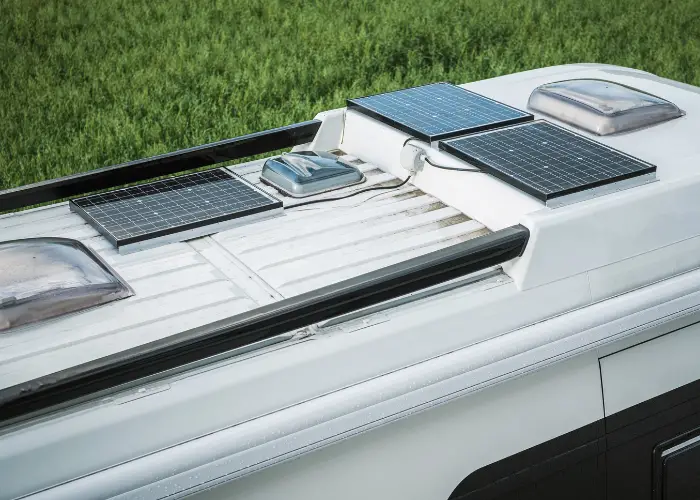
Today, electronic components have become more advanced, solar cells are much smaller than when first developed and the prices have dropped considerably since they were first developed. I love my solar electrical system and it literally has allowed me to stay in comfort at places where I couldn’t have stayed just 10-20 years ago.
For a better understanding on how to install a solar electrical system on your RV, please take a look at my colleague Lindsey’s article where she give you an excellent tutorial about installing solar power on her RV. Also, take a look at our picks for the best RV solar panels.
- 【Efficient Performance】The 200W Solar Panel Starter Kit will produce an average of 1000Wh of...
- 【Solid Quality】Advanced encapsulation material with multi-layered sheet laminations protects...
- 【Smart Function】The Wanderer PWM Charge Controller is compatible with four different types of...
Last update on 2025-06-16 / Affiliate links / Images from Amazon Product Advertising API
I have an inverter and a converter in my RV electrical system. AC vs DC
No, an rv power converter is used when you are hooked up to shore power at a campground and it converts your 110 volt AC power down to 12 volt DC power to keep your house batteries fully charged.
On the other hand, an inverter is used when you are not on shore power and want to use 110v for something like a coffee maker, microwave or television and this inverts your power from 12v DC power to 110v AC power. You can read my article on how to install an inverter for more info.
Proper setup for wiring, breakers, and fuses
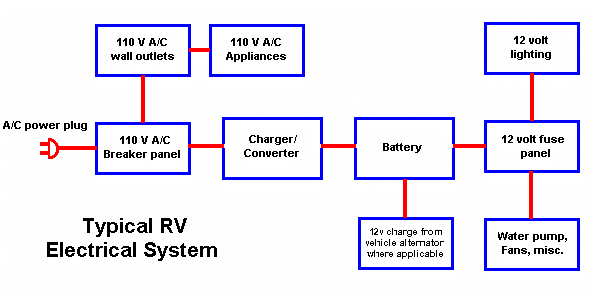
As I said earlier, RV electrical systems can be simple or complicated depending upon how you want your system to perform. In this diagram you’ll see that this is the most common RV electrical set-up and the basic type most often installed by manufacturers.
Normally, when you plug your RV into shore power, the current flows to your 110v A/C breaker panel where it is then dispersed to your RV electrical outlets for plugging in small appliances, 110v lights or electronics. It also will send current for some appliances such as larger exhaust fans or water heaters that are hard wired directly.
The breaker panel will also send a 110v current into the charge converter that I explained earlier. Remember, the converter reduces that 110v to 12v where it is stored and recharges your house batteries, part of your electrical system.
Once here, the 12v current will then supply electricity to a fuse box that works exactly as the larger breaker box that your shore power flows into initially. Smaller 12v light fixtures, your water pump, and some electronic power or chargers can also utilize your 12v power supply as well as some outdoor lighting and even your furnace fan motor.
You should also take note that in this schematic, they included a box that represents power being supplied to your house battery/batteries. This is the electric current being supplied when you are not using shore power but are instead driving down the road or even idling your motorhome engine.
Almost every motorhome has their engine’s alternator designed to supply current to their house batteries, and many towable RVs are wired through their tow vehicle and camper connections that supply power to your camper’s electric brakes and lights when driving while also recharging your RV batteries.
Where should I put my power outlets?
Most often, this question will have no direct or specific answer. It’s really all about what you want the design of your RV to be. Simply put, where do you think the power supply outlets should be based upon your needs?
For example, if you have no reason to have an outlet next to your bathroom sink, then don’t design one into your plan. Personally, I recommend having two 110v outlets near your cooking and food storage area to supply 110v to a dual powered refrigerator as well as supplying power to a coffee maker, microwave, toaster or any other item you may want to use when connected to shore power.
I would also make sure that I had an outlet or two wired to my living area and/or bedroom, so I could access my computer, watch my TV or listen to some of my favorite music while traveling. That said, I would include 2-3 outdoor outlets on my RV to cover security lighting as well as lighting for safety.
Final thoughts
In an upcoming article, I’ll be sharing some thoughts on how to troubleshoot RV’s electrical system as well as making some repairs for common problems you may encounter with that system while you travel. One I published recently is a guide on what to do when RV battery won’t charge. Until then folks, thanks for reading and as always, I hope to see you out there someday.
For other electrical work, read these related articles.





